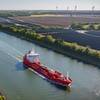By Larry Pearson
Many workboats in the marine industry are called upon in supply or assist roles. The entire offshore vessel industry is based on a supply function to oil and gas drilling operations or the resupply of production platforms. The tugboat industry is most often characterized as small vessels assisting very large ships in docking, undocking and other harbor movements.
The growth of these vessel companies and their operations depends on the economic vitality of the larger industry they serve. Right now the hottest new market being served by tugs is in the assistance of very large Liquid Natural Gas (LNG) tankers to dock and undock.
As is the case in other marine support operations, the growth of tugs to assist LNG tankers depends on the basic health of LNG transport. Now and in the near future the growth of the LNG industry is good, very good. There are 137 such tankers active in the world and over 50 on order.
These vessels are all built in Europe or Asia and are about 900 ft. long; 140 ft. wide with a 36-ft. draft and the largest can hold 140,000 cu. m. of LNG. The LNG is shipped from countries such as Algeria, Trinidad, Norway, Qatar, Oman and Venezuela. In total there are 17 LNG export terminals in operation.
LNG is mostly methane and is shipped as a liquid, the fuel's most compact state. It is chilled to -260 degrees when it is loaded onto the tankers. The gas can presently be offloaded (and regasified) at one of four import sites…Everett, Mass.; Lake Charles, La.; Elba Island, Ga. and Cove Point, Md.
With the dramatic increase in LNG tankers under construction there is a likewise renewed interest in developing more import facilities in the United States…as many as three in the Gulf of Mexico and others on both Coasts of the United States...possibly 30 in all.
With new tankers and additional import sites comes the need for more escort tugs. Most ships of this size need at least two tugs to guide the vessels safely into port.
For example, Washburn & Doughty of East Bootbay, Maine delivered two such tugs in 2003 and one of a two-vessel contract in 2004.The two 2003 vintage tugs, Freedom and Liberty were order by Boston Towing & Transportation Company. They were designed to fulfill BTT's contract with Tractebel LNG Shipping North America LLC who operate the Everett, Mass LNG import and regasification plant.
These two tugs each have 4,400 hp of propulsion power coupled to "Z" drives. They measure 92- by 32 ft. with a 13.75-ft. draft and have an estimated bollard pull of 110,000 pounds forward and 105,000 pounds astern.
Main engines are Caterpillar 3516B with electronic fuel injection powering Rolls Royce Z drives with 86-in. stainless steel propellers in kort nozzles. Two Caterpillar 3304 diesels each deliver 99 kW of ship's electrical power. The vessels are outfitted with two 3,000 gpm Alco fire monitors and Aurora centrifugal pumps each powered by a Caterpillar 3304 diesel.
The ability of these tugs to deliver water on a fire is a critical design feature in case of an accident to one of the tankers. LNG is not flammable in itself since it has no oxygen component, but if the liquid escapes from the tanker it would turn to gas and mixed in the right proportion with water would produce a blaze that is difficult to extinguish.
One of the features of the firefighting equipment on these tugs is deluge in which the tug would be enveloped with water to prevent fire damage to the tug.
The most advanced LNG tanker assist tugs yet built are the two Washburn & Doughty is building for the Moran Towing Corporation of New Canaan, Conn.
The Kaye E. Moran has the same hull as the vessel built in 2003, but has more power, advanced firefighting capabilities and other advances.
The two vessels are being built for Moran to provide ship-assist services at the newly reopened Dominion Cove Point LNG storage facility on the Chesapeake Bay near Baltimore, Md.
Cove Point is the largest LNG import facility in the country with a storage capacity of 5 billion cu. ft. (BCF) of natural gas and a daily send-out rate of one BCF, enough energy to run 3.5 million homes daily.
Cove Point takes the LNG from ships, stores it on shore and then transforms it back to a gas for use. Cove Point connects via its own pipeline to the major Mid-Atlantic gas transmission pipelines in the area.
The Kaye E. Moran features EMD-12-645F7B engines developing a total of 5,000 hp.
The vessel is the first to be classified ABS Firefighting 1 and has an escort notation. The Firefighting 1 classification requires two monitors each capable of producing 5,280 gpm for a distance of 394 feet and at a height of 148 ft. plus a deluge system and the ability to remain on station for a minimum of 24 consecutive hours.
To enable the Kaye E Moran to meet these stringent ABS firefighting rules requires large pumps and the engines to power them. Caterpillar 3412C engines rated at 900 hp each power Nijhuis pumps and output through SKUM electric FiFi 1 monitors mounted aft on the upper deck. There is also a deluge sprinkler system and eight fire stations on the main deck.
A pair of 99 kW gensets provides electrical power to the tug. Bollard pull is estimated at 135,000 pounds.
The second tug James R. Moran will be delivered this summer. Both tugs feature significant improvements in sound attenuating. Studies have proven that crews are much more efficient working in low noise environments, especially if they have to remain on duty for extended periods of time that may accompany a firefighting episode. "These are very special kinds of tugboats," said senior vice president Ned Moran. "We are happy to invest in this type of equipment because it puts us at the forefront of the kind of technology that is needed to perform well in the LNG industry."
Moran also provides tug assist for LNG tankers calling on the Elba Island plant near Savannah. About 60 tankers a year arrive at the Georgia location since it reopened in 2001.
As many as 90 tankers could be arriving yearly at the Cove Point facility, depending on the price of natural gas and the rate of natural gas consumption. The increased use of natural gas as the basic feedstock for electric utilities is one factor that has driven up demand for natural gas.
Cove Point has an offshore terminal located about one mile into the Chesapeake Bay capable of unloading two tankers at once. The facility has an underground bike tunnel connecting the offshore terminal with the mainland containing the liquid LNG tank farm.
Cove Point was opened in the mid-1970's and processed LNG only between 1978 and 1980 and has been shutdown for nearly two decades prior to its reopening in mid 2003. Low demand coupled with low prices shuttered Cove Point, as domestic production of natural gas was sufficient to meet demand.
Dominion Energy feels the future of liquid LNG is secure as they are presently building a fifth containment tank at Cove Point. This will add 2.5 billion cubic feet of storage capacity. The tank is scheduled to come on line in 2005.
Subscribe for
Maritime Reporter E-News
Maritime Reporter E-News is the maritime industry's largest circulation and most authoritative ENews Service, delivered to your Email five times per week










